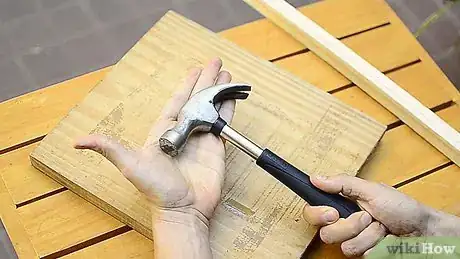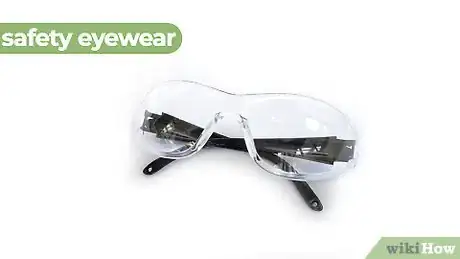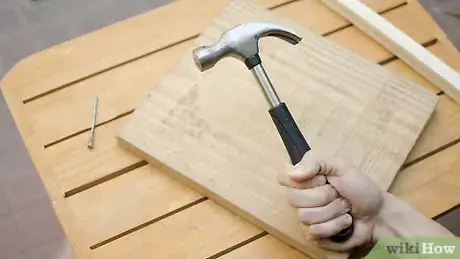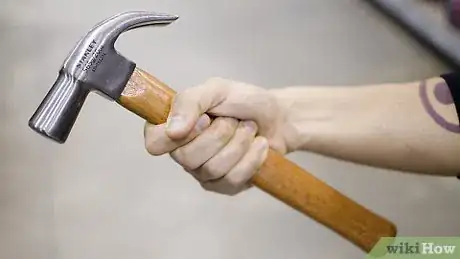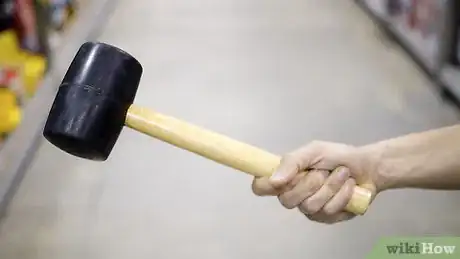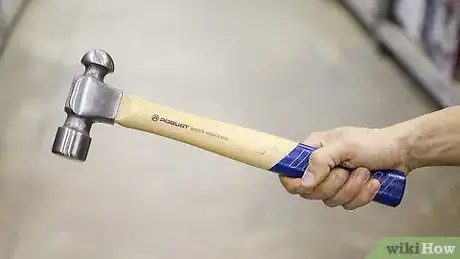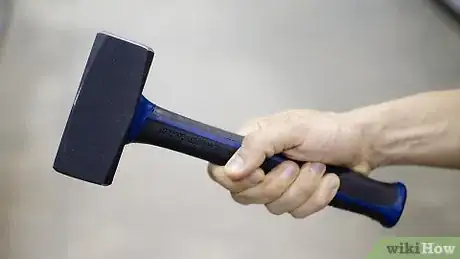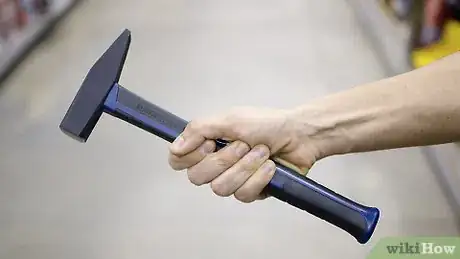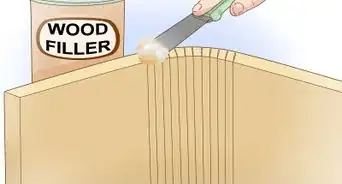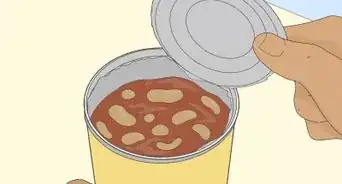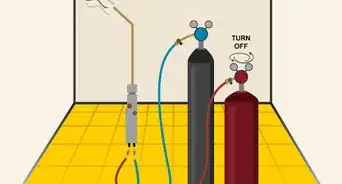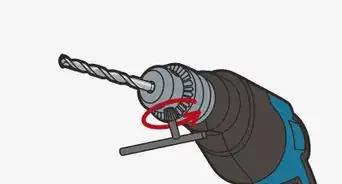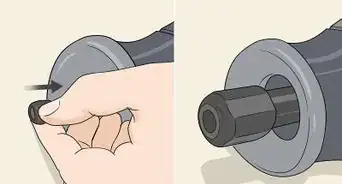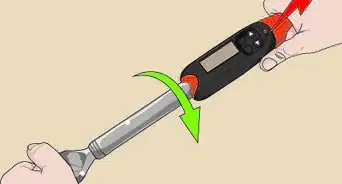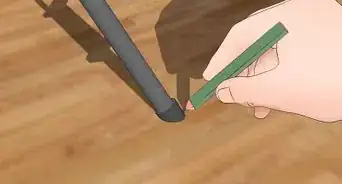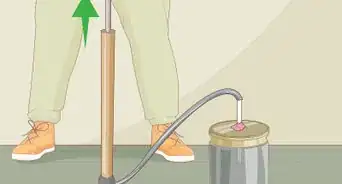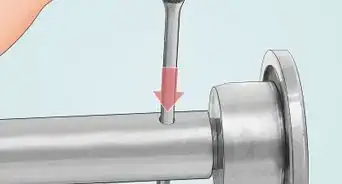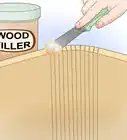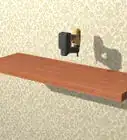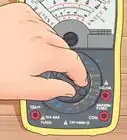This article was co-authored by wikiHow Staff. Our trained team of editors and researchers validate articles for accuracy and comprehensiveness. wikiHow's Content Management Team carefully monitors the work from our editorial staff to ensure that each article is backed by trusted research and meets our high quality standards.
There are 9 references cited in this article, which can be found at the bottom of the page.
The wikiHow Video Team also followed the article's instructions and verified that they work.
This article has been viewed 234,816 times.
Learn more...
A hammer is an easy-to-use, effective tool for all kinds of projects. However, when using a hammer, it is important that you take the necessary safety precautions and use the tool correctly so you don’t injure yourself or others. Ensure you have the right hammer for your job, and wear safety glasses to protect your eyes. With a bit of preparation and attention to detail, you can easily use a hammer without injuring yourself.
Steps
Taking Basic Safety Precautions
-
1Inspect the hammer before using it to ensure it’s in good condition. Do not use a hammer if it is rusty, the wood is splintering, or if the head is loose. Using a hammer that is not in good working order can result in injuries.[1]
- For example, if the head of the hammer is loose, it can fly off when swinging it. If you can, use a screwdriver to tighten the nails. If not, you may have to replace the hammer.
- If the wood is splintered, the hammer can break upon impact.
-
2Clean the hammer before you get started if it is dirty. If you notice dirt, oil, or debris on the hammer while you inspect it, be sure to wipe it down with a clean cloth. If there is oil or debris left on your hammer, it may slip out of your hands when using it.[2]
- Avoid using water, as this can cause the hammer to rust.
Advertisement -
3Wear safety eyewear to protect against flying items. You could injure or lose your eye if a nail or other flying object hits it. When you put on the safety glasses, make sure your entire eye area is covered and the strap is tightly secured.[3]
-
4Stay focused on what you’re doing at all times to prevent injury. If you are distracted or daydreaming while working, you can wind up hurting yourself by mistake. Stay present as you work, and keep your attention on the hammer. This way, you are less likely to have an accident.[4]
- If you daydream while working, you could wind up hitting your fingers instead of the nails.
Swinging the Hammer Correctly
-
1Look behind you before you swing the hammer to avoid injuries. If you swing the hammer without double-checking first, you can injure yourself or others passing by. Before you start banging away, take a glance over your shoulder to ensure no one is behind you and that there are no overhanging items.[5]
- For instance, look behind you to ensure there are no wires hanging from above that your hammer could catch.
- Without peeking behind you, you may accidentally hit someone while getting ready to swing the hammer.
-
2Grip the hammer by the end of the handle. Wrap your fingers around the handle so your thumb sits on top of the shaft. This way, you can have the most control over your hammer.[6]
- Positioning your thumb on top helps you control the amount of force used to drive your item.
-
3Hold the hammer tightly so it doesn’t slip out of your hands. If your grip is loose, the hammer may go flying as you swing it, which could injure yourself or the object you’re working on. Squeeze the handle firmly as you use it so the hammer stays in place.[7]
-
4Line up the hammer and item before swinging for an accurate strike. To prevent hitting your fingers by mistake, line the head of the hammer up to the item before you make your first swing. Doing this helps you focus your aim, ensuring a straight, solid strike. After you line up the hammer and the item, strike it with even force.[8]
- For example, hold the nail up to the wall and bring the tip of the hammer over top of the head of the nail.
-
5Start with a light blow before increasing your power. If you are hammering a nail into a wall or a board, hold the nail to the surface, and gently tap the nail with the hammer until it stays in place. Use light, consistent force as you do this so the nail goes in straight and secure. After the nail is in place, you can use moderate, even force to drive the nail the rest of the way in.[9]
- After the nail sets, you can move your hand out of the way so it doesn’t get whacked.
- This way, you can avoid injuring your fingers or using too much force.
-
6Swing the hammer with your entire arm. If you aren't driving a nail into the wall, grip your hammer from the end, ensure you have a tight hold, and bring your arm above your head. Swing the hammer with moderate, consistent force using both your arm and elbow.[10]
- For instance, do this if you are breaking down drywall or working on a car part.
Selecting the Right Type of Hammer
-
1Use a claw hammer to pound in nails. A claw hammer is the most traditional hammer type. It features a metal head, and it typically has a wooden handle. One side of the hammer is used to drive nails into wood, and the claw end of the hammer is used to remove nails. Use this to attach planks, hang artwork, or do other craftsman jobs.[11]
- The claw section of the hammer is the back, pronged part. If you need to remove a nail, hold the hammer upside down, align the claw with the nail, and pull up with moderate pressure. As you do this, be mindful of flying objects.[12]
- Claw hammers come in many different shapes, sizes, and weights. Some also come in solid metal varieties.
-
2Go for a mallet if doing handwork or assembling furniture parts. Mallets are a good option if you are working with lightweight items you don’t want to damage with excessive force. Choose from wood mallets or rubber mallets. Wooden mallets are used to chisel wood or work on the fine detail of woodworking projects. Rubber mallets work well to deliver a strong blow without much bounce-back, which makes it great for working on furniture.[13]
- The larger the mallet, the greater the swinging power.
- For example, use a small rubber mallet to hammer in tent stakes while camping.
- If you need to strike a hard object like a wrench or hammer, use a rubber or wooden mallet to do this. If you use another metal item to strike a metal object, it can result in injury.
-
3Select a ball peen hammer for driving a chisel or punch. The ball peen hammer is typically made from solid metal, and it has a rounded top great for pounding metals. Use these to shape metals such as rivets or to reach into small spaces.[14]
- This hammer is commonly used by metalworkers.
- For example, if you are trying to reinforce a deck and can’t fit your claw hammer into the crevice, try using a ball peen hammer instead. It has a smaller profile, making it great for hard-to-reach areas.
-
4Try using a sledgehammer if you are working on a demolition site. Sledgehammers are commonly used for knocking over assemblies or tearing down drywall. They often have a long, wooden handle and a heavy metal head. The head of the sledgehammer is cylindrical and even on both sides.[15]
- Sledgehammers are some of the heaviest hammer types, weighing about 11 lbs (5 kg), so use extra caution when swinging these varieties.
-
5Opt for a body mechanic’s hammer if working on automobiles. This hammer has a small, curved anvil often called the “dolly,” which is made of metal and attached to a wooden handle. Use this hammer type to remove dents from car panels, for example.[16]
- This hammer type is only used for auto work. Do not use this hammer to drive a nail, or you could injure yourself.
Community Q&A
-
QuestionWhy should I avoid hitting a hammer head against a hardened steel surface?
 Community AnswerThe tip of the hammer is fragile. If you bang it against a steel surface, the tip of the hammer has a chance to send metal shards flying.
Community AnswerThe tip of the hammer is fragile. If you bang it against a steel surface, the tip of the hammer has a chance to send metal shards flying. -
QuestionHow do I hammer a nail correctly?
 Community AnswerHold the nail in place with steady fingers. Begin lightly tapping on the nail with the hammer until the nail no longer needs to be held in place. Move your fingers out of the way and begin hitting the nail harder and steadier in straight blows.
Community AnswerHold the nail in place with steady fingers. Begin lightly tapping on the nail with the hammer until the nail no longer needs to be held in place. Move your fingers out of the way and begin hitting the nail harder and steadier in straight blows. -
QuestionWhy should I grip a hammer near the end?
 Community AnswerWhen you grip the end, it allows more power and accuracy, and it keeps your knuckles safe.
Community AnswerWhen you grip the end, it allows more power and accuracy, and it keeps your knuckles safe.
Warnings
- Do not use your hammer as a lever, wedge, or resting post. Using the hammer for anything other than hammering may cause the head and the handle to weaken over time.⧼thumbs_response⧽
- Avoid self-repairing a hammer handle with tape. Instead, purchase a new one.⧼thumbs_response⧽
- If you don’t have a hammer, never use a pump shaft, derrick pin, or other makeshift tools instead. You could hurt yourself or the item you are working on.⧼thumbs_response⧽
References
- ↑ http://www.iadc.org/safety-meeting-topics/hand-tool-safety-using-hammers-safely/
- ↑ http://www.iadc.org/safety-meeting-topics/hand-tool-safety-using-hammers-safely/
- ↑ https://www.safetyandhealthmagazine.com/articles/safe-hammer-handling-2
- ↑ http://www.iadc.org/safety-meeting-topics/hand-tool-safety-using-hammers-safely/
- ↑ http://www.iadc.org/safety-meeting-topics/hand-tool-safety-using-hammers-safely/
- ↑ https://www.safetyandhealthmagazine.com/articles/safe-hammer-handling-2
- ↑ https://youtu.be/AH7NIgPkXFw?t=39s
- ↑ https://www.safetyandhealthmagazine.com/articles/safe-hammer-handling-2
- ↑ https://www.safetyandhealthmagazine.com/articles/safe-hammer-handling-2
- ↑ https://www.safetyandhealthmagazine.com/articles/safe-hammer-handling-2
- ↑ https://youtu.be/AH7NIgPkXFw?t=1m34s
- ↑ https://youtu.be/AH7NIgPkXFw?t=2m2s
- ↑ https://youtu.be/uSf_TKmSyas?t=2m15s
- ↑ https://www.popularmechanics.com/home/tools/g1923/the-23-hammers-everyone-should-know/?slide=8
- ↑ https://www.popularmechanics.com/home/tools/g1923/the-23-hammers-everyone-should-know/?slide=20
- ↑ https://www.popularmechanics.com/home/tools/g1923/the-23-hammers-everyone-should-know/?slide=2
